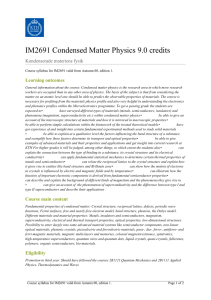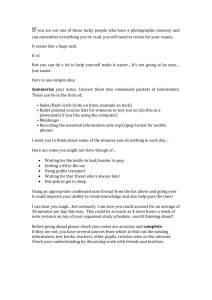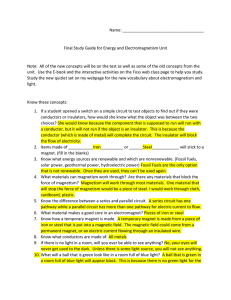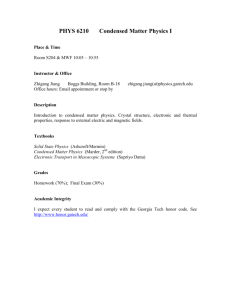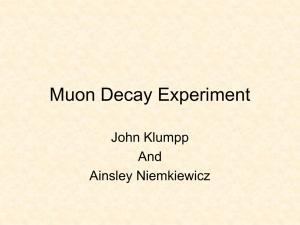lancaster_huddersfield
advertisement
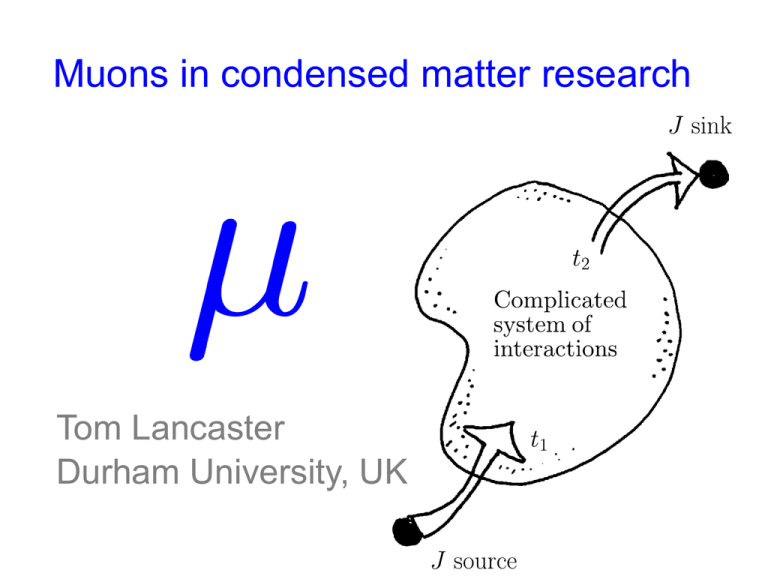
Muons in condensed matter research Tom Lancaster Durham University, UK Condensed matter physics in a nutshell Lev Landau (1908-1968) T>TC T<TC T>TC T<TC What can we do with muons? Muonium (Mu= μ+e-) as light hydrogen Mu vs. H atom Chemistry: - gases, liquids & solids - best test of reaction rate theories - Study “unobservable” H atom rxns. - Discover new radical species Mu vs. H in Semiconductors: - Until recently, μ+SR → only data on metastable H states in semiconductors! The muon μ+ as a probe Probing Magnetism: unequalled sensitivity - Local fields: electronic structure; ordering - Dynamics: electronic, nuclear spins Probing Superconductivity: - Coexistence of SC & Magnetism - Magnetic Penetration Depth λ - Coherence Length ξ Quantum Diffusion: μ+ in metals (compare H+) Mu in nonmetals (compare H) Muon spectrometers at ISIS muSR HiFi muons cryostat quadrupole magnet Helmholtz magnet photomultiplier tubes Example: Muons as a probe of magnetism in condensed matter Uniformly weakly magnetic Non-magnetic, with strongly magnetic impurities or Susceptibility gives average information and therefore can give the same response for the situations sketched above SR gives local information and therefore can distinguish between these two situations. Cu(NO3)2(pyz) S=1/2 Cu2+ chains with J=10.3 K Muons reveal order at 107 mK We estimate J’=0.046 K 26 T=36 mK (a) T=120 mK (c) (b) T=405 m 2.0 22 1.5 i (MHz) 18 1.0 14 0.5 10 6 0.0 1.0 2.0 t ( s) 3.0 0.0 1.0 2.0 t ( s) 3.0 0.0 1.0 2.0 t ( s) 3.0 0.0 0.0 0.02 0.04 0.06 T (K) 0.08 0.1 0.12 Phys Rev B 73 020410 (2006) Superconductivity The physics of vortices Vortices: topological excitations in condensed matter Vortices are not stable on their own They cost an infinite amount of energy Due to swirliness at infinity One solution: stabilize a vortex with a (magnetic) field This is how a vortex lattice in a superconductor is formed The only way to do this involves quantized flux 30 20 A(t) (%) 10 0 -10 -20 -30 0.0 10 K 100 K 0.2 0.4 0.6 0.8 t ( s) Muons measure the superfluid stiffnessn m (or penetration length) 1.0 Tc 30 20 A(t) (%) 10 0 -10 -20 -30 0.0 10 K 100 K 0.2 0.4 0.6 0.8 t ( s) 1.0 1.2 1.4 The Uemura plot Tc 30 20 A(t) (%) 10 0 -10 -20 -30 0.0 10 K 100 K 0.2 0.4 0.6 0.8 1.0 1.2 132 104 8 1.4 t ( s) X 83 Tc 30 20 A(t) (%) 10 0 -10 -20 -30 0.0 10 K 100 K 0.2 0.4 0.6 0.8 1.0 1.2 132 104 8 1.4 t ( s) X 83 What can be done for vortices can be done for other topological excitations Example: the skyrmion lattice What can be done for vortices can be done for other topological excitations Cu2OSeO3 arXiv:1410.4731 Semiconductors: muonium as light hydrogen Mu = μ+e- bound state Energy levels of muonium in an applied field Scale set by hyperfine interactions Semiconductors in brief Hydrogen is present in all semiconductors Muonium is a similar defect Two muonium sites: 1) Tetrahedral 2) Bond centred A rare example of being able to study metastable states in matter Transport and diffusion Provides fundamental information on quantum diffusion and, more recently, on charge transport in energy materials. Conclusions • Muons are a powerful tool for studying condensed matter systems • Recent successes include insights into pnictide superconductivity, low-dimensional magnetism, battery materials… • Bare muons are (mainstream) probes of magnetism and superconductivity • Muonium spectroscopy remains uniquely powerful in condensed matter and chemistry Relaxation rate allows us to determine the spin transport mechanism Rate determined by the autocorrelation function f(ω) Diffusion: f(ω) ~ ω-1/2 Ballistic: f(ω) ~ ln(J/ω) F.L. Pratt et al., PRL 96 247203 (2006) Evidence for spin diffusion In Cu(pyz)(NO3)2 Power law fits for TN<T<J give n≈0.5 Power law fit gives unphysical value when T>J and when used for 2D compound. F. Xiao et al. in preparation (2014). The magnet is a toy universe Using molecules we can build magnets with a variety ground states Each ground state is a vacuum for a toy universe Dimensionality determines the behaviour of the magnet (or universe) In two dimensions: Flatland Dimensionality determines the behaviour of the magnet or universe In one dimension: Lineland Sidney Coleman (1937-2007) No magnetic order for Heisenberg chains and planes above T=0 Example: specific heat
